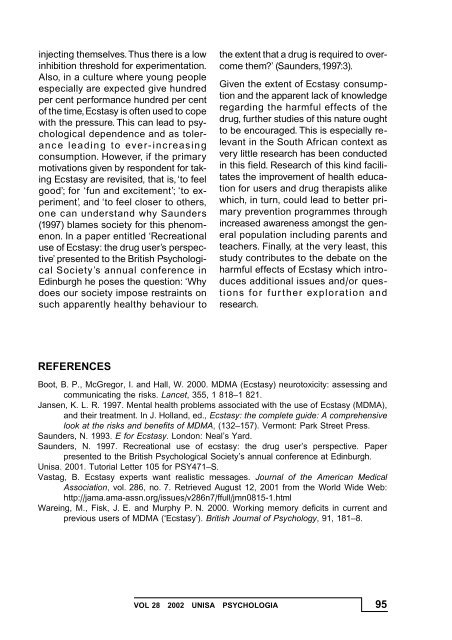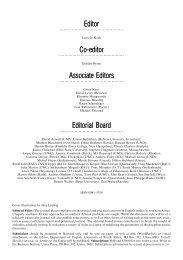Editorial The - University of South Africa
Editorial The - University of South Africa
Editorial The - University of South Africa
Create successful ePaper yourself
Turn your PDF publications into a flip-book with our unique Google optimized e-Paper software.
injecting themselves. Thus there is a low<br />
inhibition threshold for experimentation.<br />
Also, in a culture where young people<br />
especially are expected give hundred<br />
per cent performance hundred per cent<br />
<strong>of</strong> the time, Ecstasy is <strong>of</strong>ten used to cope<br />
with the pressure. This can lead to psychological<br />
dependence and as tolerance<br />
leading to ever-increasing<br />
consumption. However, if the primary<br />
motivations given by respondent for taking<br />
Ecstasy are revisited, that is, `to feel<br />
good'; for `fun and excitement'; `to experiment',<br />
and `to feel closer to others,<br />
one can understand why Saunders<br />
(1997) blames society for this phenomenon.<br />
In a paper entitled `Recreational<br />
use <strong>of</strong> Ecstasy: the drug user's perspective'<br />
presented to the British Psychological<br />
Society's annual conference in<br />
Edinburgh he poses the question: `Why<br />
does our society impose restraints on<br />
such apparently healthy behaviour to<br />
the extent that a drug is required to overcome<br />
them?' (Saunders,1997:3).<br />
Given the extent <strong>of</strong> Ecstasy consumption<br />
and the apparent lack <strong>of</strong> knowledge<br />
regarding the harmful effects <strong>of</strong> the<br />
drug, further studies <strong>of</strong> this nature ought<br />
to be encouraged. This is especially relevant<br />
in the <strong>South</strong> <strong>Africa</strong>n context as<br />
very little research has been conducted<br />
in this field. Research <strong>of</strong> this kind facilitates<br />
the improvement <strong>of</strong> health education<br />
for users and drug therapists alike<br />
which, in turn, could lead to better primary<br />
prevention programmes through<br />
increased awareness amongst the general<br />
population including parents and<br />
teachers. Finally, at the very least, this<br />
study contributes to the debate on the<br />
harmful effects <strong>of</strong> Ecstasy which introduces<br />
additional issues and/or questions<br />
for further exploration and<br />
research.<br />
REFERENCES<br />
Boot, B. P., McGregor, I. and Hall, W. 2000. MDMA (Ecstasy) neurotoxicity: assessing and<br />
communicating the risks. Lancet, 355, 1 818±1 821.<br />
Jansen, K. L. R. 1997. Mental health problems associated with the use <strong>of</strong> Ecstasy (MDMA),<br />
and their treatment. In J. Holland, ed., Ecstasy: the complete guide: A comprehensive<br />
look at the risks and benefits <strong>of</strong> MDMA, (132±157). Vermont: Park Street Press.<br />
Saunders, N. 1993. E for Ecstasy. London: Neal's Yard.<br />
Saunders, N. 1997. Recreational use <strong>of</strong> ecstasy: the drug user's perspective. Paper<br />
presented to the British Psychological Society's annual conference at Edinburgh.<br />
Unisa. 2001. Tutorial Letter 105 for PSY471±S.<br />
Vastag, B. Ecstasy experts want realistic messages. Journal <strong>of</strong> the American Medical<br />
Association, vol. 286, no. 7. Retrieved August 12, 2001 from the World Wide Web:<br />
http://jama.ama-assn.org/issues/v286n7/ffull/jmn0815-1.html<br />
Wareing, M., Fisk, J. E. and Murphy P. N. 2000. Working memory deficits in current and<br />
previous users <strong>of</strong> MDMA (`Ecstasy'). British Journal <strong>of</strong> Psychology, 91, 181±8.<br />
VOL 28 2002 UNISA PSYCHOLOGIA 95
















